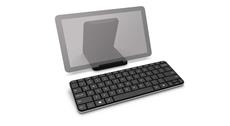Microsoft in Education Global Forum, Dubai, 2...
0 comments
 2
2 Earlier, I went on a quest of using tablets with Ease of Access. Yet, “Vision Free” describes a specific person—a powerhouse user of technology. Despite the seeming importance of a visual display, it can be bypassed through assistive technology. Touchscreens are an irrelevant feature, an extraneous aesthetic.
Screen reading software is one of the primary technologies that are responsible for this shift. Microsoft’s built-in program, Narrator, reads text aloud, and provides description of events—like error messages.
Let’s return to driving. A glance to check a text message or maps might seem insignificant, but traffic changes instantly. I could limit distractions by turning on the audio in Maps on my Windows Phone. My newest passenger gives the right directions (for a change), and read my texts aloud. 
Alternative modes of input can eliminate the touchscreen altogether. By pairing with a portable keyboard, a user can tab or arrow key through content. Speech Recognition can be set up as another mode of input. Just like Narrator talks to the user, a user can talk to their device. A user can verbalize commands, and their device will understand, and respond to, their voice. 